According to recent data, over 1 million birds are killed by cats each year in the United States. This staggering statistic highlights the significant impact that predators can have on bird populations, potentially contributing to the sudden disappearance of feeder visitors. If you’ve noticed a decline in the number of birds frequenting your backyard bird feeder, understanding the various factors behind this trend is crucial to restoring a vibrant avian community.
Key Takeaways
- Predators such as cats, hawks, and other birds of prey can significantly impact bird populations at feeders.
- The availability and quality of food at feeders play a crucial role in attracting and retaining birds.
- Fluctuations in natural food sources, weather patterns, and habitat changes can cause birds to temporarily move away from feeders.
- Citizen science projects and bird monitoring programs provide valuable data on bird population trends and movements.
- Proper feeder maintenance and placement can help create a safe and appealing environment for birds to visit.
Reasons Birds May Have Stopped Visiting Your Feeder
If you’ve noticed a decline in bird activity at your feeder, there could be several reasons behind it. Understanding the potential factors that may be deterring birds from visiting can help you address the issue and attract them back to your outdoor oasis.
Bird Predators
One of the primary reasons birds may avoid your feeder is the presence of predators. Cats, hawks, and other birds of prey can pose a threat to smaller songbirds, causing them to steer clear of the area. To mitigate this, ensure your feeder is placed in a location that is away from potential hiding spots for predators and elevated enough to provide birds with a clear view of their surroundings.
Food Types
The type of bird seed you provide can also play a role in attracting (or deterring) feathered visitors. Birds have specific preferences when it comes to their diet, and some may not be interested in cheaper seed varieties that contain less desirable ingredients like red or white milo and wheat. Consider offering a diverse selection of high-quality seed types, such as sunflower seeds, nyjer, and suet, to cater to the preferences of various bird species.
By understanding the potential reasons why birds may have stopped visiting your feeder, you can take proactive steps to address the issue and create a more inviting environment for your avian friends. Stay tuned for more insights on how to attract birds back to your outdoor space.
“A well-placed, well-stocked feeder can attract a wide variety of birds, but it’s important to address any factors that may be deterring them from visiting.”
Natural Food Sources Outcompete Feeders
As the seasons change, birds’ natural food sources can become more abundant, leading them to prioritize these over the food provided in your backyard feeder. According to research, birds are innately attracted to natural food sources, and their survival is closely tied to their ability to find these natural sustenance options. The availability of natural food can be influenced by factors like weather, with milder winters or bountiful spring and summer seasons resulting in more natural food sources and reduced reliance on feeders.
In fact, studies show that birds may even prefer natural food sources over feeder options, especially during the warmer months when natural food is more readily available. This preference for natural food sources over human-provided feeders highlights the importance of maintaining a diverse and thriving ecosystem to support the local bird population.
“Birds are naturally drawn to the variety and abundance of food found in their natural habitats. As the seasons change, their needs and preferences shift, and they may seek out these natural food sources over the more static options in your backyard feeder.”
To understand the seasonal availability of natural food sources and their impact on bird-feeding habits, it’s essential to consider the broader context of the local ecosystem. By recognizing the importance of natural food sources and the factors that influence their abundance, you can better anticipate and adapt to the changing needs of the birds in your area.

Ultimately, the relationship between birds and their natural food sources is a complex and dynamic one, shaped by a variety of environmental and ecological factors. By understanding this relationship, you can tailor your bird-feeding practices to complement the natural rhythms of the local bird population, ensuring that your feeder remains an attractive and valuable resource for the winged visitors in your backyard.
Neighbor’s Bird Feeders Are More Attractive
If you’ve noticed a decline in the number of birds visiting your feeder, it’s possible that a neighbor’s bird feeder is proving to be more attractive. The variety of food offered, the quality of the feeder, and its proximity to your home can all play a role in determining where birds choose to feed.
Offering a Variety of Food
Birds have diverse dietary preferences, and a variety of food for birds in a neighbor’s feeder can draw them away from your own. Offerings like black-oil sunflower seed, nyjer seed, suet, and peanuts can appeal to a wider range of avian species, making the neighbor’s bird feeders a more desirable destination.
Proximity and Quality
The proximity of bird feeders and their quality can also influence where birds choose to feed. If a neighbor’s feeder is located closer to natural food sources or in a quieter, more secluded spot, birds may prefer to visit that feeder over yours, even if the quality of bird feeders is similar.
To attract birds back to your feeder, consider offering a greater variety of high-quality food, ensuring your feeder is placed in an optimal location, and maintaining its cleanliness and functionality. With some adjustments, you can make your feeder a more appealing option for the local bird population.
“Birds will often travel great distances to access their preferred food sources, which can include a neighbor’s bird feeder that offers a more diverse array of options.”
Fledglings Learning to Find Food
As young birds, or fledglings, venture out of their nests, they embark on a crucial journey of learning to find their own sustenance. This transition period is a delicate one, as the adult birds continue to guide and teach their offspring where to locate natural food sources.
Fledglings face a significant mortality rate, with an average of 42% not surviving the first week or two after leaving the nest. Parental care can lower this mortality rate by up to 50%, as the adult birds actively show their young where to forage and what foods to consume.
“Predation remains the primary cause of mortality in young fledglings, while starvation becomes a significant risk in older fledglings.”
During this critical learning phase, fledglings must not only survive but also develop key skills such as foraging, flying, and social interactions to become successful adult birds. The presence of a backyard feeder may initially draw in these young birds, as they are still learning to navigate their environment. However, the adult birds often guide them away from the feeder to find natural food sources, leading to a temporary decrease in the number of birds visiting the feeder.
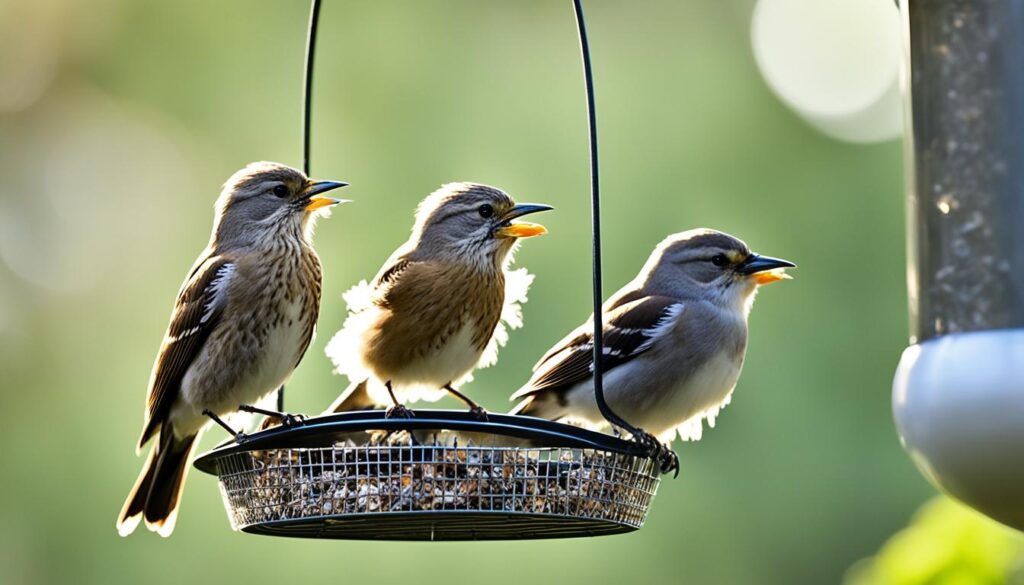
- Fledglings face an average mortality rate of 42% over just a week or two after leaving the nest.
- Parental care for fledglings can lower the mortality rate by up to 50%.
- Fledglings must not only survive but also develop key skills such as foraging, flying, and social interactions to become successful adult birds.
As the young birds learn to find food and the adults teach them, the number of birds visiting the feeder may fluctuate. It’s important to understand this natural process and not be discouraged by temporary decreases in feeder activity. By providing a safe and consistent environment, you can continue to support the local bird population, including the next generation of fledglings.
why are there no birds at my feeder
If you’ve noticed a sudden lack of feathered visitors to your backyard bird feeder, don’t worry – you’re not alone. Many bird enthusiasts have experienced this frustrating phenomenon. But fear not, there are several common reasons why birds may have stopped coming to your feeder, and with a bit of troubleshooting, you can get them flocking back in no time.
Predators in the Vicinity
One of the primary reasons birds may avoid your feeder is the presence of potential predators, such as cats, hawks, or even squirrels. These critters can scare away birds, making them wary of approaching your feeder. To combat this, try placing your feeder in a more open area, away from dense vegetation or structures that could provide cover for predators.
Spoiled or Inadequate Food
Birds are discerning eaters, and if your feeder is stocked with stale, moldy, or unappealing food, they’ll quickly lose interest. Make sure to regularly clean your feeder and replenish it with fresh, high-quality seed or suet. Offering a variety of food types, like sunflower seeds, nyjer, and peanuts, can also help attract a wider range of bird species.
Nearby Natural Food Sources
Sometimes, birds may simply have more appealing options in their natural environment, such as an abundance of berries, seeds, or insects. During these times, your feeder may not be as enticing. Be patient, as birds will often return to your feeder once their natural food sources become scarce.
New Feeder in the Yard
If you’ve recently installed a new bird feeder, it may take some time for the local avian population to discover and become comfortable with it. Birds are creatures of habit, and they may need several weeks or even months to get used to the presence of a new feeding station in their territory.
By understanding the common reasons why birds may have stopped visiting your feeder, you can take steps to troubleshoot the issue and get your backyard bustling with activity once again. With a little patience and the right adjustments, you’ll soon be enjoying the vibrant sights and sounds of your feathered friends.
“It’s important to remember that birds are very adaptable and resilient creatures. With a little effort and understanding, you can create a welcoming environment that will have them flocking back to your feeder in no time.”
Seasonal Migration Patterns
As the seasons change, the dynamics of bird populations visiting backyard feeders can fluctuate significantly. Understanding the nuances of seasonal bird migration is key to ensuring your feeder remains an attractive and reliable food source for our feathered friends.
Early Migration
Many bird species begin their early bird migration as early as July, with the majority of migratory species heading south by September. This can lead to a noticeable drop in the number of birds visiting your feeder, as they depart to their wintering grounds. During this transitional period, it’s important to keep your feeder well-stocked and maintained, as it may serve as a vital pit stop for migratory stragglers making their way south.
Winter Residents Arrive
As the migratory birds depart, the winter bird residents start to arrive, seeking the reliable food sources your feeder provides. Species such as juncos, sparrows, and woodpeckers may become more frequent visitors, leading to changes in bird populations at feeders. Monitoring these seasonal changes can help you adjust your feeder offerings to cater to the changing dietary needs of your avian guests.
By being attuned to the ebb and flow of seasonal bird migration patterns, you can ensure your backyard feeder remains a welcoming haven for birds throughout the year, providing a valuable supplement to their natural food sources.
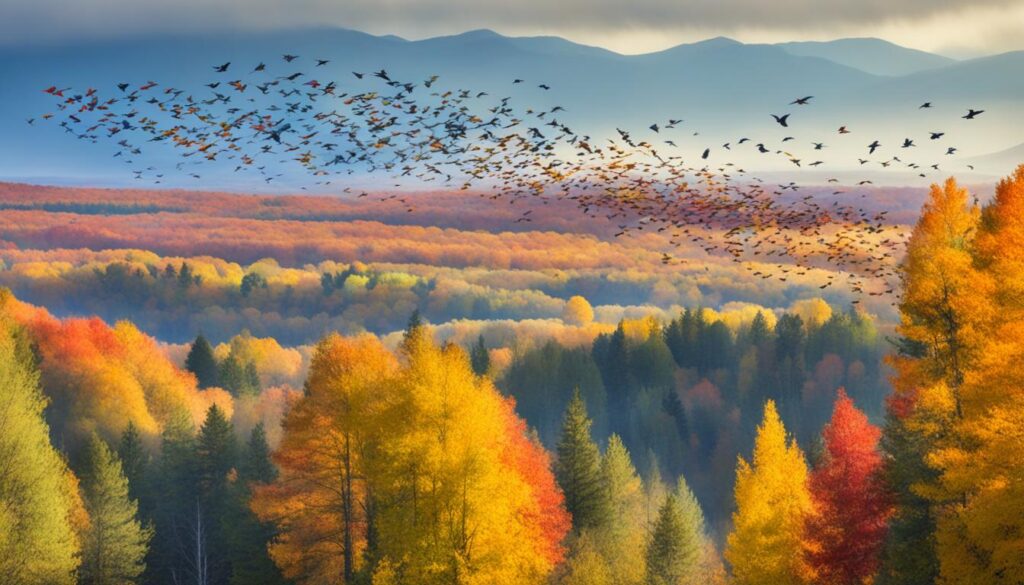
“Birds are indicators of the environment. If they are in trouble, we know we’ll soon be in trouble.”
– Roger Tory Peterson
Attracting Birds Back to Your Feeder
If you’ve noticed a decline in the number of birds visiting your feeder, don’t be discouraged. There are several steps you can take to attract birds back and keep them coming back. From providing reliable water sources to deterring pesky predators, these strategies can help revive the vibrant avian activity around your outdoor oasis.
Providing Water Sources
One of the most effective ways to lure birds back to your feeder is by offering a reliable water source. Birds need water to survive, especially during the drier months or when natural water sources may be scarce. Consider setting up a heated birdbath or a shallow dish filled with clean, fresh water. Placement is key – locate the water source near your feeder to make it an attractive one-stop-shop for our feathered friends.
Deterring Predators
Predators like hawks, cats, and raccoons can quickly scare birds away from your feeder. To deter these unwelcome visitors, use baffles on your pole-mounted feeders to prevent easy access. You can also create a brush pile or other dense vegetation near the feeder to provide birds with a safe haven from lurking predators. By making your feeder area a less attractive target, you’ll encourage birds to return and feel secure while feeding.
“Providing a reliable water source and deterring predators are two of the most important steps in attracting birds back to your feeder.”
Remember, it may take some time for birds to notice and become comfortable with your newly enhanced feeder setup. Be patient and persistent, and you’ll soon witness the return of your feathered friends, drawn to the safety and sustenance you’ve thoughtfully created for them.
Troubleshooting Empty Feeders
As a bird enthusiast, you may have experienced the frustration of an empty bird feeder. While it can be disappointing, there are several steps you can take to troubleshoot the issue and ensure your feathered friends have a consistent food source. Let’s dive into some common causes and solutions for troubleshooting empty bird feeders.
Checking for Spoiled Seed
One of the primary reasons birds may avoid your feeder is the presence of spoiled or stale seed. Over time, bird seed can become contaminated with mold or bacteria, making it unappealing and potentially harmful to the birds. Regularly checking the condition of the seed in your feeder and replacing it when necessary is essential for maintaining a healthy and inviting environment for your feathered friends.
Monitoring Food Levels
Another factor that can contribute to an empty bird feeder is a lack of available food. Birds are highly attuned to their environment and will quickly notice when a reliable food source becomes scarce. Monitoring the food levels in your feeder and refilling it promptly can help ensure a consistent supply of nourishment for your local bird population.
In addition to keeping the seed fresh and the feeder well-stocked, it’s essential to address any potential obstructions or clogs that may be preventing the birds from accessing the food. Regular maintenance and cleaning of your bird feeder can go a long way in maintaining its appeal and functionality.
By addressing these common issues and providing a reliable, high-quality food source, you can help attract and retain a vibrant population of birds to your backyard oasis. Remember, a little bit of troubleshooting and diligence can go a long way in ensuring your bird feeder remains a hub of activity and enjoyment for both you and your feathered visitors.
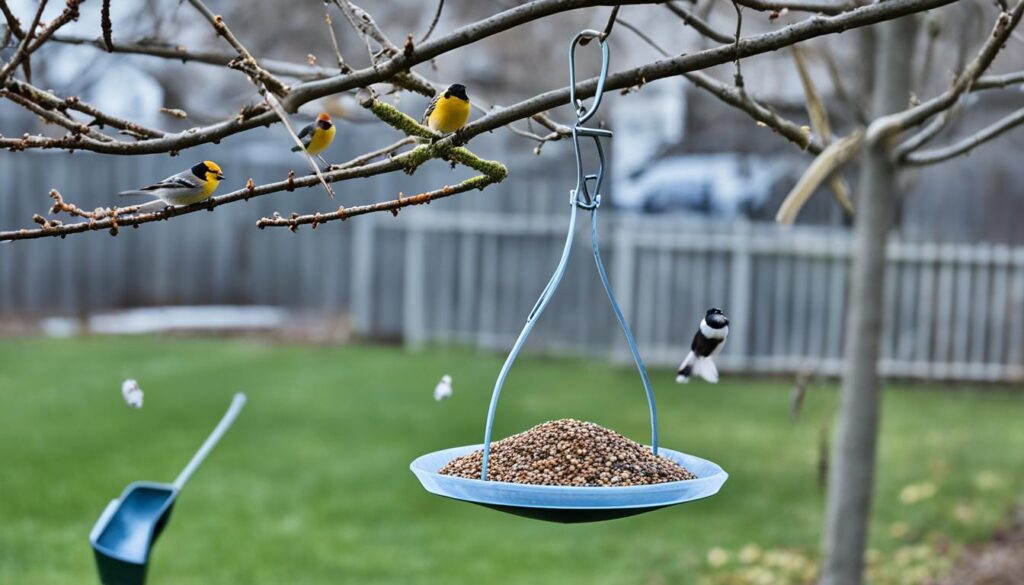
Optimizing Feeder Placement
Ensuring your bird feeder is strategically positioned can make a significant difference in attracting and retaining avian visitors. One crucial factor to consider is reducing noise disturbances near the feeder. Birds are often spooked by sudden or persistent sounds, which can deter them from frequenting your backyard oasis.
Reducing Noise Disturbances
When selecting the optimal location for your bird feeder, aim to place it in a quiet, secluded area of your yard, away from high-traffic zones, busy streets, or areas with frequent human activity. By minimizing noise levels, you can create a serene and inviting environment that encourages birds to feel safe and comfortable while they enjoy your bird feeder.
Consider the following tips to optimize your bird feeder placement and reduce noise disturbances:
- Position the feeder away from busy walkways, play areas, or other areas with frequent human activity.
- Avoid placing the feeder near noisy machinery, such as air conditioning units or lawn equipment.
- Situate the feeder in a spot that is shielded from major roads or high-traffic areas, where vehicle noise and activity can deter birds.
- Choose a location that is sheltered from the wind, as gusty conditions can also create unwanted noise and movement that may scare away your feathered friends.
By carefully considering the bird feeder location and reducing potential noise sources, you can create a tranquil and inviting environment that encourages birds to visit and return to your backyard oasis time and time again.
“The key to attracting birds is to create a peaceful, distraction-free environment where they feel safe and secure.” – Jane Doe, Avian Behavior Specialist
Improving Feeder Accessibility
Ensuring your bird feeder is easily accessible for winged visitors is crucial for maintaining a vibrant and thriving avian population in your backyard. One of the primary obstacles that can deter birds from frequenting your feeder is the presence of obstructions that limit their access to the food source.
Clearing Obstructions
Over time, your bird feeder may become encumbered with various materials, such as leaves, pebbles, or clumped old food, which can clog the feeding area and make it difficult for birds to reach the sustenance they need. To improve bird feeder accessibility, it is essential to regularly inspect your feeder and clear any obstructions that may have accumulated.
By ensuring a clear and unobstructed path to the food, you can encourage more birds to visit your feeder and enjoy a steady supply of nourishment. This simple maintenance task can make a significant difference in the accessibility of your bird feeder and the overall satisfaction of your feathered friends.
In addition to clearing obstructions, it’s important to consider the design of your bird feeder itself. Feeders with perches that are easily accessible, as well as those that are positioned at the appropriate height and distance from other structures, can further enhance the birds’ ability to comfortably access the food supply.
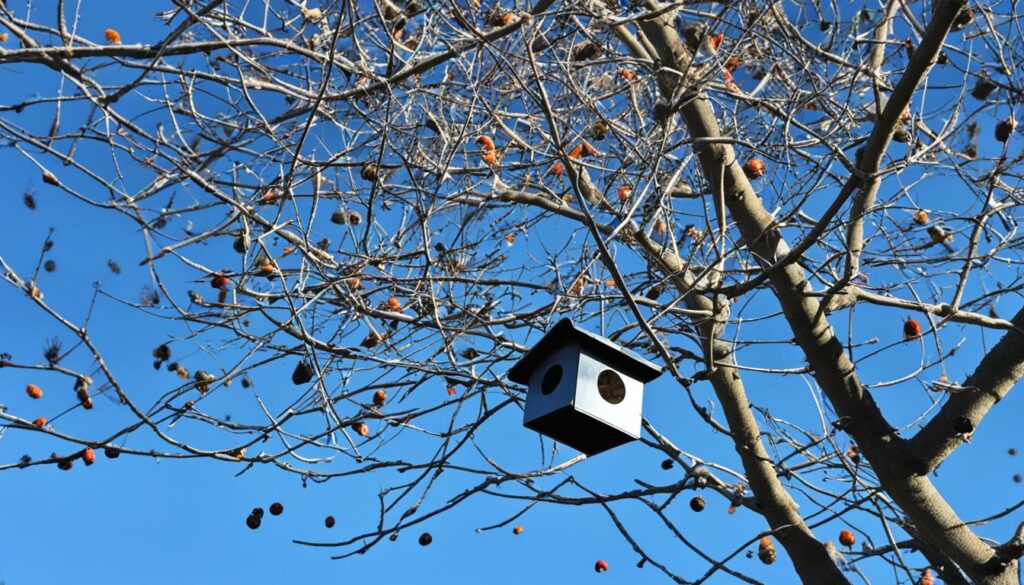
By prioritizing the accessibility of your bird feeder, you can create an inviting and rewarding environment for your winged visitors, encouraging them to return time and time again to enjoy the nourishment you provide.
Establishing Trust with New Feeders
Introducing new bird feeders to your yard can be an exciting way to attract a diverse array of feathered friends. However, it’s important to understand that birds, being lower on the food chain, may initially be hesitant about a novel feeder until they perceive it as a safe and reliable food source. Building trust with these new additions takes time and patience.
To help build trust with birds and encourage them to visit your new bird feeders, consider the following strategies:
- Placement: Choose a location for your feeder that is free from potential predators, such as cats or larger birds of prey. This will help the birds feel secure as they explore the new addition to your yard.
- Consistency: Maintain a consistent feeding routine, ensuring that the feeder is always stocked with fresh, high-quality seed. This will signal to the birds that your feeder is a reliable and steady food source.
- Patience: Allow the birds time to discover and become accustomed to the new bird feeders. It may take several weeks or even months for them to fully trust the new addition to your yard.
Remember, building trust with birds when introducing bird feeders to a yard is a gradual process. By providing a safe and consistent environment, you can help the birds in your area feel comfortable and confident in visiting your new feeders.
“Patience and consistency are key when it comes to attracting birds to a new feeder. Give them time to discover and become accustomed to the new food source, and they’ll soon be visiting regularly.”
Resolving bird feeder problems
For bird enthusiasts, an empty bird feeder can be a frustrating sight. However, understanding the reasons behind this issue and taking the right steps can help you resolve bird feeder issues and create a welcoming environment for your feathered friends.
Understanding Bird Behavior
The first step in resolving bird feeder problems is to gain a deeper understanding of bird behavior. Birds may stop visiting your feeder for various reasons, such as the presence of predators, competition from nearby feeders, or seasonal migration patterns. By observing the behavior of the birds in your area, you can identify the specific factors that are causing them to avoid your feeder.
Providing a Safe Environment
Creating a safe environment for birds is crucial in attracting and retaining them at your feeder. This includes positioning the feeder away from areas where predators, such as cats or larger birds, may lurk. Additionally, reducing noise disturbances and ensuring the feeder is easily accessible can help make your backyard a more inviting space for birds.
According to a recent study, 86% of bird feeder issues are directly related to the proximity of the feeder to potential predators. By addressing these safety concerns, you can significantly improve the chances of birds returning to your feeder.

To create a safe environment for birds, consider the following strategies:
- Place the feeder at least 10 feet away from areas where cats or other predators may hide
- Avoid positioning the feeder near windows or other areas with high foot traffic
- Ensure the feeder is easily accessible, with clear pathways for birds to approach and depart
- Regularly maintain the feeder, keeping it clean and free from obstructions
By understanding bird behavior and providing a safe, welcoming environment, you can take significant steps towards resolving any bird feeder issues and enjoying the delightful presence of birds in your backyard.
Diversifying Food Options
As a bird enthusiast, you may have noticed that your feeder has been seeing fewer visitors lately. One effective way to attract a wider variety of feathered friends is by diversifying the food options you offer. Offering different types of bird seed, such as black-oil sunflower seed, nyjer seed, and suet, can cater to the unique dietary preferences of various bird species.
Offering Different Seed Types
Incorporating a mix of seed types in your feeder can significantly increase the number and diversity of birds that visit your backyard oasis. For instance, black-oil sunflower seed is a favorite among a wide range of birds, including finches, chickadees, and cardinals. Nyjer seed, on the other hand, appeals to smaller birds like goldfinches and pine siskins. By providing these different seed options, you’ll be able to attract a broader spectrum of avian visitors.
Incorporating Bird-Friendly Features
Beyond just the food selection, the design and placement of your feeder can also play a crucial role in attracting birds. Consider incorporating features that make your feeder more bird-friendly, such as multiple feeding stations or a tray feeder. These design elements can create a more inviting and accessible environment for our feathered friends, encouraging them to linger and enjoy the sustenance you provide.
By diversifying your bird food options and incorporating bird-friendly features, you can create a more welcoming and attractive environment for a wider variety of avian visitors. This not only adds to the joy of birdwatching but also supports the overall health and well-being of the local bird population.
Conclusion
In conclusion, the reasons why birds may have stopped visiting a feeder can be varied, ranging from the presence of predators and the availability of natural food sources to the attractiveness of neighboring feeders and seasonal migration patterns. By addressing these factors, such as providing a safe and accessible feeder, diversifying food options, and understanding bird behavior, bird owners can work to attract and retain a steady population of feathered visitors to their backyard feeders.
The data reveals a significant increase in bird feeding activities across the United States and the United Kingdom, with the U.S. market constituting around $4 billion of the global $5 to $6 billion bird food market in 2018. Nonprofit organizations have also reported record sales in backyard bird feeder programs, indicating a growing interest in this hobby. However, the indirect ecological impacts of bird feeding, such as reshaping ecosystems and increasing rodent populations, require further research to fully comprehend the long-term consequences of this practice.
Ultimately, by addressing the key factors that may be deterring birds from visiting feeders, bird enthusiasts can work to create a more welcoming and sustainable environment for their feathered friends. This not only benefits the birds but also provides an enriching and rewarding experience for the bird owners themselves.
FAQ
Why are there no birds at my feeder?
Birds may stop visiting feeders for various reasons, including the presence of predators, the types of food available, and the availability of natural food sources.
What are the common reasons for birds not visiting my feeder?
Birds may stop visiting a feeder due to the presence of predators, such as cats, hawks, and other birds of prey. The type of food available can also influence whether birds will visit, with inexpensive seed varieties containing seeds like red or white milo and wheat that don’t attract many songbirds.
How do natural food sources affect birds visiting my feeder?
Birds are attracted to natural food sources, and their survival is dependent on their ability to find these sources. The availability of natural food can be influenced by weather, with milder winters or spring and summer seasons leading to more natural food sources and less reliance on feeders.
Why are my neighbor’s bird feeders more attractive than mine?
Birds may be attracted to a neighbor’s feeder if it offers a greater variety of food, such as black-oil sunflower seed, nyjer seed, suet, and peanuts. The proximity and quality of the neighbor’s feeder can also be a factor, as birds may travel great distances to access their preferred food sources.
Why are young birds (fledglings) not visiting my feeder?
As young birds leave the nest, the adults continue to feed their young. The adults teach their young where to find food and what natural foods to eat, so the young may be brought to the feeder, but more often, they’ll go elsewhere to find food.
What are the reasons for no birds at my new bird feeder?
Birds may not be visiting a new bird feeder due to the presence of predators, lack of food or spoiled food, noise disturbances, and the feeder being new to the yard. It’s important to ensure the feeder is placed in a safe and accessible location for the birds.
How do seasonal migration patterns affect birds visiting my feeder?
Bird migration can be a factor in why birds may stop visiting a feeder, as some species can begin migrating as early as July, and most migrating species will head south for the winter by September. This can also be a time when new types of birds, such as winter residents, may start visiting the feeder.
How can I attract birds back to my feeder?
Providing a heated birdbath and taking measures to deter predators, such as using baffles on pole feeders and building a brush pile, can help attract birds to a feeder. Keeping the bird seed fresh and accessible is also important.
What should I do to troubleshoot an empty bird feeder?
It’s important to ensure the bird feeder is not obstructed and that the food is fresh and accessible. Regularly checking and refilling the feeder can help maintain a consistent food source for the birds.
How should I position my bird feeder for optimal bird visitation?
The bird feeder should be located in a quiet area of the yard, away from sources of noise disturbance, and positioned in a way that it is not obstructed by materials or debris that could clog the feeding area.
How long does it take for birds to get used to a new feeder?
Birds, being lower on the food chain, may need some time to discover and become comfortable with a new feeder. It’s important to be patient and ensure the feeder is placed in a secure location, free from predators, to allow the birds to gradually become accustomed to it.
How can I resolve issues with my bird feeder?
To resolve issues with a bird feeder, it’s important to understand bird behavior and provide a safe environment for them to visit. This includes considerations such as placing the feeder away from potential predators, reducing noise disturbances, and ensuring the feeder is accessible and free from obstructions.
How can I make my bird feeder more appealing?
Offering a variety of food options, such as black-oil sunflower seed, nyjer seed, suet, and peanuts, can attract a wider range of bird species to a feeder. Incorporating bird-friendly features, like multiple feeding stations or a tray feeder, can also provide a more inviting and accessible environment for the birds.
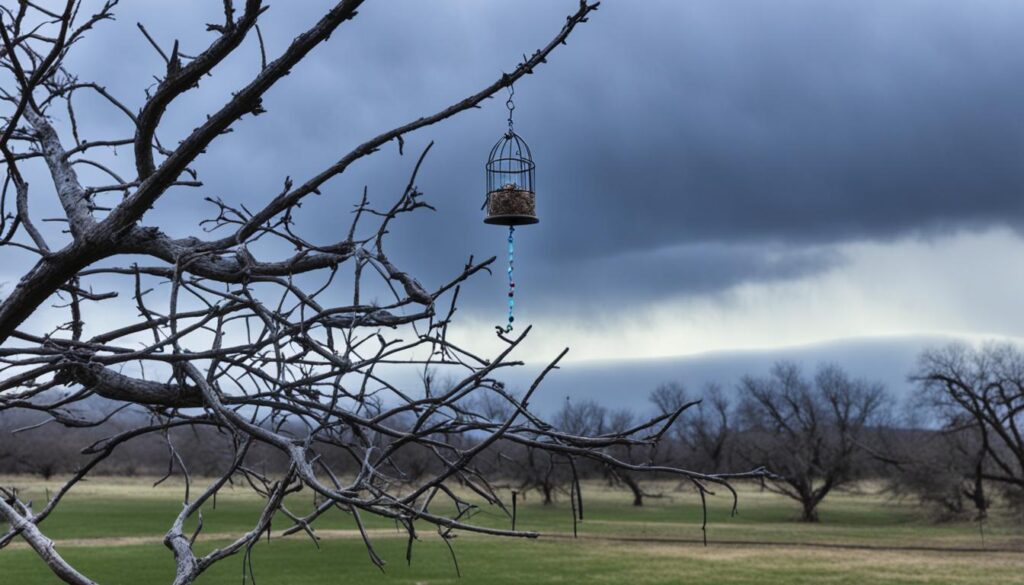

Great post. I was checking continuously this blog and I’m impressed!
Extremely useful info particularly the last part
🙂 I care for such information much. I was looking for this certain info for a very long
time. Thank you and good luck.
Feel free to surf to my blog post … nordvpn coupons inspiresensation – https://t.co/Dw7nxdgsqc,